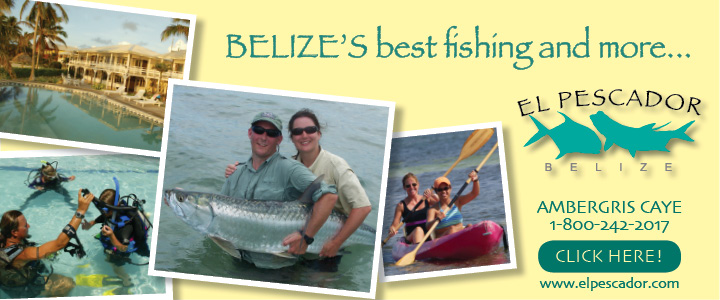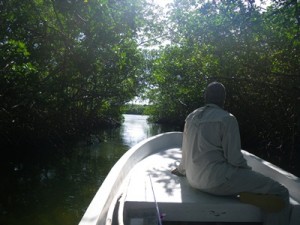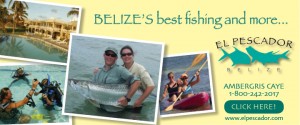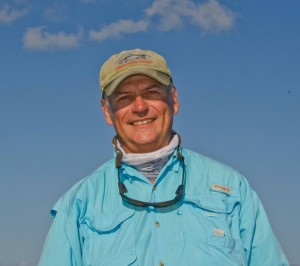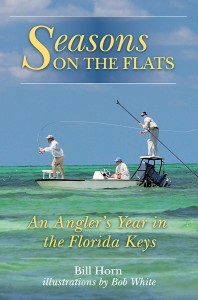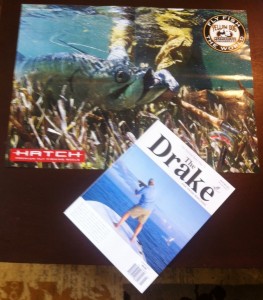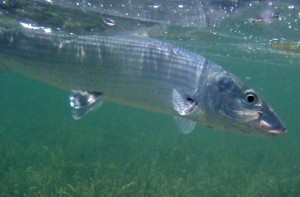I am up early, 4:30 AM, the last day at El Pescador. I could fish for bonefish, and I love bonefish, catching as many as I have time for, but I’m starting to understand things about flats fly fishing. When the King is holding court, you attend.
Tomas, my guide for the day, is waiting for me before the sun breaks over the horizon. “I should have told you last night to leave at 4” he says. I think a 5 AM push off is pretty good, especially in the light of it being the last day of my honeymoon. My wife is in bed, asleep I hope and I’m off to hunt tarpon between Ambergris and the mainland. As we get into the panga to depart the air is still, the water calm, the silence loud. It is pure smoothness as we slide through the water, heading West.
Soon, our first stop. A mangrove island full of bird calls. The sun is just emerging, but is hidden behind a wall of gray. Clouds coming from the East have stalled with no more wind to carry them. One massive cloud sits above us, seemingly forgetting its race across the sky, content to look down on Ambergris, on us.
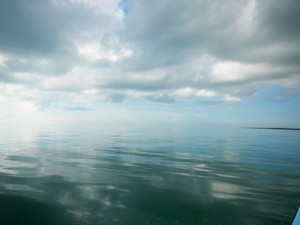
Stillness
The water, still and unmoving, reflecting the grey underbelly of this huge cloud, is indistinguishable from sky. We try to peer into sheets of cold, grey steel.
We wait and watch for rolling fish. There is only stillness and birdsong.
Reel up and run.
The cloud has not moved. The air is still. The sun is climbing. The water still impenetrable. The fish hidden.
Reel up and run. This time all the way to the mainland where the same story is told. We have not seen a fish.
We run back to the East and find a break in the clouds, but the glare on the water is still difficult, still like trying to see through polished steel.
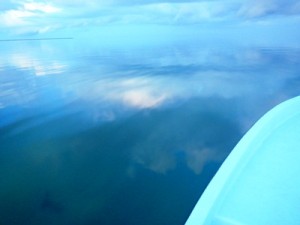
Totally still.
The air remains static and while we finally have the lights on I now grasp the other disadvantage of a windless day on the water. The heat. It is hot. Really hot. I try to find even an inch or two of shade from the low gunwales on the bow of the panga to provide respite to my baking feet. The light blue deck is molten.
“Gulp.”
Tarpon breaking. We see them. They are in range and I make the cast, landing the light 3/0 bunny 3 feet in front of the lead fish. He charges, inhales, I strike viciously and the fish bolts into the air. I bow, the fish lands and the fly parts company with the fish, excused.
Damn.
“We’ll get the next one in the boat” says Tomas.
He’s wrong.
The next one I won’t see in the glare and I’ll put the fly right on his head. He’ll bolt.
The next one is too close to the boat to cast to.
The next one is 30 feet too far away.
The next one isn’t interested.
The next one I line.
The next one I can’t see and again put the fly on his head, which he is not keen on.
As we search for fish the wind is an absent player, but in place of the wind is the heat. It is smothering, intense heat. I have sweat dripping down the backs of my legs. My shirt is soaked. My feet, even through my polarized lenses, look bright, fire red. I feel like I am losing gallons of water a minute, but I’m hesitant to take my eyes off the water to get more fluids. I don’t want to miss the King.
The next fish I spot just as Tomas is about to point it out. I say “Tarpon, 12 o’clock” and point my rod. Tomas says “yes!” A school of 5, maybe 7, heading right at us. I cast, a good cast, and the lead fish charges the fly and crushes it. I strip set, feel the fish and then, inexplicably, sweep the rod. The fly is out, but the fly is still in play. I strip again and the second fish charges. I set. I feel the fish. I set again. The fish leaps in the air. I bow. I still have the fish. I start to think about getting the fish on the reel, getting ready for the battle. The fish jumps again and I bow and the fly… it unbuttons.
Tomas has no complaints. He says I did everything right, on the second fish.
Tomas does not say we’ll get the next one in the boat.
The next fish I cast behind.
The next fish comes with a gang and follows, chases the fly too close to the boat, but the school is still there. I cast in the middle of the milling fish and one smashes the bunny before I can get ready. The chance is gone and so are the fish.
There is no next fish. I realize if we actually find another fish I wouldn’t have the time to fight it. The trip is done, the honeymoon is about to be too, but this was a good day. I got my shots and I just didn’t convert. This is why we play the game.
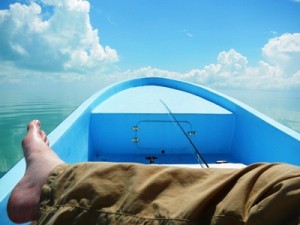
A beautiful, wonderful, windless day in Belize.
“If it were easy, everyone would do it” says Tomas.
—
